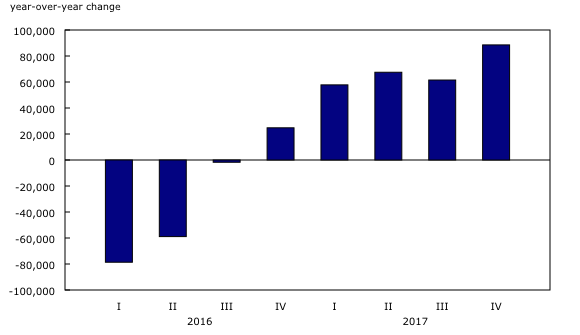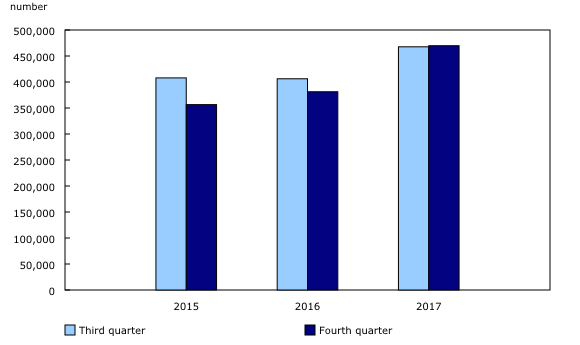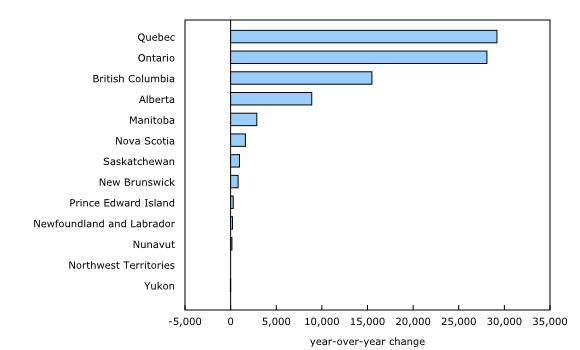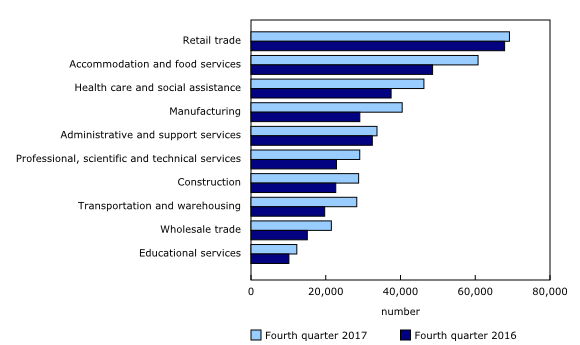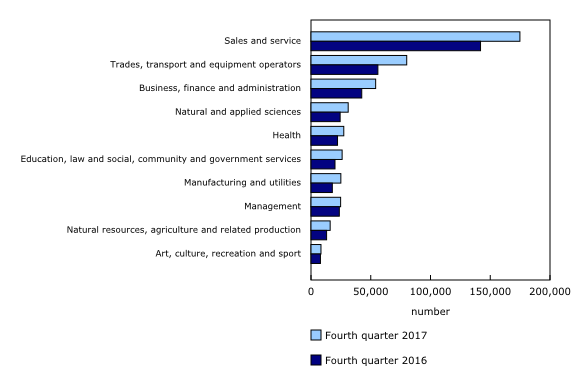Job vacancies, fourth quarter 2017
Archived Content
Information identified as archived is provided for reference, research or recordkeeping purposes. It is not subject to the Government of Canada Web Standards and has not been altered or updated since it was archived. Please "contact us" to request a format other than those available.
Released: 2018-04-12
There were 470,000 job vacancies among Canadian employers in the fourth quarter, up 89,000 (+23.2%) from the fourth quarter of 2016, the largest year-over-year increase since the start of the series in 2015. Over the same period, the job vacancy rate rose 0.5 percentage points, reaching 2.9%.
The job vacancy rate represents the number of job vacancies expressed as a percentage of labour demand; that is, the sum of all occupied and vacant jobs.
This was the fifth consecutive quarter with year-over-year increases in both the number of job vacancies and the job vacancy rate. Job vacancies rose across most provinces, industrial sectors and occupational groups in the quarter.
Compared with the third quarter of 2017, the number of job vacancies and the job vacancy rate in Canada (both unadjusted for seasonality) were little changed in the fourth quarter. By comparison, the number of job vacancies and the job vacancy rate declined between the third and fourth quarters of both 2015 and 2016.
The average offered hourly wage for job vacancies was $20.10 in the fourth quarter of 2017, up $0.50 or 2.6% compared with the same quarter one year earlier. Overall, nearly 7 out of every 10 job vacancies were for full-time work.
Quebec and Ontario led growth in job vacancies
Compared with the fourth quarter of 2016, job vacancies rose in nine provinces, with the largest increases registered in Quebec and Ontario. Job vacancies were little changed in Newfoundland and Labrador, the Northwest Territories, and Yukon. Year-over-year increases in the job vacancy rate were also widespread across provinces.
In the fourth quarter, employers in Quebec reported 29,000 (+46.1%) more job vacancies than in the same quarter a year earlier. Rises in job vacancies were widespread across industrial sectors, most notably in manufacturing; accommodation and food services; and finance and insurance. The job vacancy rate in this province rose by 0.8 percentage points to 2.6%, the largest increase among the provinces. Most economic regions (ERs) in this province registered notable year-over-year increases in their job vacancy rate, including Chaudières-Appalaches, where the rate was up 1.7 percentage points to 3.3%, and Capitale-Nationale, where the rate rose 1.4 percentage points to 3.1%. In these two ERs, the job vacancy rate in both manufacturing and in accommodation and food services recorded notable increases. Over the same period, data from the Labour Force Survey (LFS) showed that the unemployment rate in Quebec declined 1.1 percentage points to 5.5%, compared with a national rate of 6.0%.
Employers in Ontario had 28,000 (+17.3%) more job vacancies in the fourth quarter compared with a year earlier. At the same time, the job vacancy rate rose 0.4 percentage points to 3.0%. This was the sixth consecutive quarter with year-over-year increases in the number of job vacancies for this province. Vacancies rose in 15 of the 20 industrial sectors, including in health care and social assistance and in accommodation and food services. Job vacancies were up in all provincial ERs, led by Toronto, Hamilton–Niagara Peninsula, and Kitchener–Waterloo–Barrie. Within Ontario, occupations in sales and services saw the largest increase in job vacancies (+11,000), which was partly driven by a rise in food counter attendants, kitchen helpers and related support occupations.
There were 89,000 job vacancies in British Columbia in the fourth quarter, up 15,000 (+21.2%) from the same quarter in 2016. The job vacancy rate increased from 3.4% to 4.0% over the same period, the highest rate in the country. Increases in vacancies were broadly based across sectors, with the largest rises in accommodation and food services, as well as in construction. These increases helped raise the provincial job vacancy rate in these sectors to 6.3% and 5.7%, respectively. Lower Mainland–Southwest had the highest job vacancy rate, at 4.3%, while North Coast and Nechako had the lowest, at 2.3%. The Survey of Employment, Payrolls and Hours (SEPH) indicated that payroll employment in British Columbia grew by 3.6% over the same period, the fastest growth among the provinces.
Job vacancies in Alberta were up 8,900 (+20.9%) compared with the same quarter a year earlier, driven by increases in construction; transportation and warehousing; as well as mining, quarrying, and oil and gas extraction. Job vacancies in this province have increased on a year-over-year basis since the first quarter of 2017. The job vacancy rate in Alberta rose to 2.6%, a 0.4 percentage point rise from the fourth quarter of 2016. Increases were observed in all seven provincial ERs. Banff-Jasper-Rocky Mountain House and Athabasca-Grande Prairie-Peace River (3.7%) had the highest job vacancy rate, followed by Wood-Buffalo–Cold Lake (3.2%). According to the LFS, the unemployment rate in Alberta has trended downward since the end of 2016, following an upward trend that began at the end of 2014.
Among the smaller provinces, Prince Edward Island recorded an increase of 300 (+27.1%) job vacancies in the fourth quarter. The job vacancy rate rose 0.3 percentage points to 2.0%. This was the fourth consecutive quarter with year-over-year increases in the number of job vacancies and the job vacancy rate. According to the SEPH, payroll employment in the province grew by 3.3% between the fourth quarter of 2016 and the fourth quarter of 2017.
Rise in job vacancies in 8 of the 10 largest industrial sectors
Job vacancies rose in 8 of the 10 largest industrial sectors (in terms of employment) between the fourth quarter of 2016 and the fourth quarter of 2017, led by accommodation and food services and by manufacturing. Job vacancies in administrative and support services and in retail trade were little changed over the same period.
Job vacancies in accommodation and food services were up 12,000 (+25.0%) on a year-over-year basis, with the increase concentrated in Quebec, British Columbia and Ontario. The job vacancy rate in this sector rose 0.8 percentage points to 4.4% over the same period. The job vacancy rate in accommodation and food services has been among the highest across sectors since the beginning of the series in 2015, likely reflecting relatively high turnover.
The number of job vacancies reported by employers in manufacturing was 11,000 (+39.0%) higher compared with the same quarter a year earlier. At the same time, the job vacancy rate rose to 2.6% from 1.9%. Job vacancies were up in most subsectors, led by food manufacturing, fabricated metal product manufacturing, and transportation equipment manufacturing. According to the SEPH, payroll employment in this sector has steadily increased since the second half of 2016.
The number of job vacancies in health care and social assistance rose by 8,800 (+23.4%) in the fourth quarter, driven by broad-based increases across subsectors and provinces, most notably in Ontario. The job vacancy rate for the sector rose to 2.3% in the fourth quarter, up from 1.9% a year earlier.
There were 8,600 (+43.5%) more job vacancies in transportation and warehousing in the fourth quarter compared with a year earlier. Within the sector, truck transportation and support activities for transportation registered notable increases. Provincially, there were large increases in Ontario, Quebec, and Alberta. Over the same period, the job vacancy rate for this sector rose 1.0 percentage point to 3.6%.
Widespread increases in job vacancies across broad occupational categories
Job vacancies were up in 9 of the 10 broad occupational categories in the fourth quarter. The exception was occupations in art, culture, recreation and sport, where vacancies were little changed. For the third consecutive quarter, the largest year-over-year increases were in sales and service occupations and in trades, transport and equipment operators.
There were 175,000 job vacancies in sales and service occupations in the fourth quarter, up 33,000 (+23.2%) on a year-over-year basis. The proportion of vacancies for full-time work in this category was 49.5%, among the lowest across the 10 occupational categories. Provincially, the largest increases in vacancies in sales and service occupations were in Quebec, where job vacancies were up 64.0%, followed by Ontario and British Columbia. Job vacancies rose in many of the more detailed occupational groups within the category, particularly food counter attendants, kitchen helpers and related support occupations (+11,000). This occupational group has also been among those with the highest number of vacancies since the beginning of the series.
In the fourth quarter, job vacancies in trades, transport and equipment operators rose by 24,000 (+43.1%). The rise in vacancies is consistent with the increases observed in several related sectors in the quarter: manufacturing (+11,000), transportation and warehousing (+8,600) and construction (+6,100). Increases were widespread across the more detailed occupational groups, with motor vehicle and transit drivers; trades helpers and labourers; and machining, metal forming, shaping and erecting trades reporting notable rises. Across provinces, British Columbia and Alberta had the largest increases in vacancies in this occupational category.
Although the number of job vacancies was little changed in art, culture, recreation and sport in the fourth quarter, changes were observed in more detailed occupational groups within this broad category. Job vacancies rose in photographers, graphic arts technicians and technical and co-ordinating occupations in motion pictures, broadcasting and the performing arts (+700); while they fell in creative designers and craftspersons (-600). On a year-over-year basis, the average offered hourly wage in art, culture, recreation and sport rose 17.2%. Increases in both the offered wage and vacancies in photographers, graphic arts technicians and technical and co-ordinating occupations in motion pictures, broadcasting and the performing arts, an occupation group with relatively high offered wages, contributed to a higher offered wage for the broad occupational category.
Note to readers
The Job Vacancy and Wage Survey (JVWS) provides comprehensive data on job vacancies and wages by industrial sector and detailed occupations for Canada, the provinces, territories and economic regions. Job vacancy and offered wage data are released quarterly, while data on average hourly wages paid are released annually.
JVWS data are not seasonally adjusted. Therefore, quarter-to-quarter comparisons should be interpreted with caution as they may reflect seasonal movements.
This analysis focuses on differences between estimates that are statistically significant at the 68% confidence level.
Summary statistics related to the job vacancy time series from the Survey of Employment, Payrolls and Hours are available in CANSIM.
The National Occupational Classification (NOC) is a four-tiered hierarchical structure of occupational groups with successive levels of disaggregation. The structure is as follows: 1) 10 broad occupational categories, also referred to as one-digit NOC; 2) 40 major groups, also referred to as two-digit NOC; 3) 140 minor groups, also referred to as three-digit NOC; and 4) 500 unit groups, also referred to as four-digit NOC.
Improvements were made to the occupation coding procedures starting in the second quarter of 2017. This has resulted in a decrease in the number of vacancies for which the occupation is unclassified. The new coding procedures do not affect the total number of vacancies, but may affect estimates by occupation.
Industrial sectors are classified according to the North American Industry Classification System (NAICS) 2012. The NAICS has 20 industrial sectors at the two-digit level.
Data quality of the Job Vacancy and Wage Survey
The target population of the survey includes all business locations in Canada, with the exclusion of those primarily involved in religious organizations and private households. While federal, provincial and territorial administrations are also excluded from the survey for now, they will be phased in later.
Next release
Job vacancy data from the JVWS for the first quarter of 2018 will be released on July 12.
Products
More information about the concepts and use of data from the Job Vacancy and Wage Survey is available online in the Guide to the Job Vacancy and Wage Survey (75-514-G).
The product Labour Market Indicators, by province, territory and economic region, unadjusted for seasonality (71-607-X2017002) is also available. This dynamic web application provides access to Statistics Canada's labour market indicators for Canada, by province, territory and economic region, and allows users to view a snapshot of key labour market indicators, observe geographical rankings for each indicator using an interactive map and table, and easily copy data into other programs.
Contact information
For more information, contact us (toll-free: 1-800-263-1136; 514-283-8300; STATCAN.infostats-infostats.STATCAN@canada.ca).
To enquire about the concepts, methods or data quality of this release, contact Myriam Hazel (613-219-4345; myriam.hazel@canada.ca) or Client Services (toll-free: 1-866-873-8788; statcan.labour-travail.statcan@canada.ca), Labour Statistics Division.
- Date modified:


